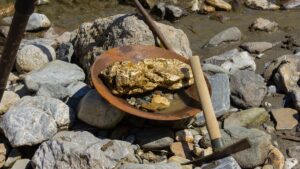Ground Breakers: Where do lithium prices go in 2024, and who’s ringing a Big Bell today?

Pic: Zia Soleil/Stone via Getty Images
- MySteel predicts spodumene price to drop below US$1400/t in 2024
- Westgold rings Big Bell on expansion at Murchison gold mine
- Lithium, gold, iron ore stocks lead materials sector higher in morning trade
Lithium has had a volatile and complex 2023.
Interest in speccy junior lithium equities remains bullish on long-term demand forecasts and the desperation of major players to stamp their foot on any potential source of future supply like they’re standing on the tail of a cartoon dog.
Or tentacles, in the case of Gina Rinehart and Chris Ellison, who now have stakes in all bar five of WA’s 14 spodumene deposits.
At the same time, Australia’s producers have been grappling with prices falling from last year’s unthinkable highs of US$80,000/t+ for chemicals and US$8000/t+ for their 6% (or less) lithium concentrate.
Chinese lithium carbonate and hydroxide prices have tumbled more than three quarters though on a classic case of oversupply and paper speculation. Having breathed and recovered mid-year, they are now less than US$20,000/t.
That has seen spodumene prices correct to US$1590/t last week according to Fastmarkets. They would remain highly profitable for Aussie producers, though there’s plenty of reflection going on around what seemed not too long ago to be an unstoppable juggernaut of an industry.
The world’s largest lithium mine Greenbushes could curb plans to expand output to 1.5Mtpa this financial year with one of its owners and offtakers, China’s Tianqi, not keen to take its full allotment of concentrate.
Are we at a bottom, a buying opportunity for the electric vehicle powered Elon Musk huffing bulls out there? Or is there more water to run under this bridge before prices stabilise?
In a note on Monday, Chinese industry monitor MySteel moved in lockstep with lithium persona non grata Goldman Sachs, predicting prices would head below US$1400/t in 2024.
MySteel senior editor Aggie Hu said rising supply from Africa, as well as low cost brines in Chile and China, would impact the balance of the sector.
Chinese lithium producers are also moving to introduce transaction terms that don’t expose them to the mismatches between spodumene and chemical prices which caused big losses in previous quarters, trying to shift from past quarter contract pricing to forward month pricing from late next year.
“The latest pricing method, M+1 or M+2, means that the lithium ore prices are settled based on the average lithium carbonate price in the next month or month after next,” Hu said.
“In this case, the smelters are able to mitigate the risks stemming from falling lithium carbonate prices, as the production cost drops along with falling lithium carbonate prices. However, the smelters will also give up the profits allowed by rebounding lithium carbonate prices.
“Generally, the lithium mines may surrender certain profits to benefit the downstream smelters amid times of difficult (sic). But the mines are still relatively tough, hence only Pilbara has accepted the new pricing method of M+1 up to now, and the rest are under negotiation.”
Westgold rings more life out of Big Bell
Fresh off a major debt deal that pumps up its financial muscle for a potential acquisition, Westgold Resources (ASX:WGX) is moving to shore up the life of its existing operations in the Murchison.
Up over 125% YTD, Westgold continues to ring more water from the towel at its network of Mid-West gold mines, shortly after the reopening of the Great Fingall mine at its ~250,000ozpa West Australian gold ops.
Wayne Bramwell’s $960 million producer now has 16 years ahead of it at Big Bell, where long hole open stoping below an existing sub-level cave from the first half of FY25 will see it mine some 1.5Moz of gold at grades lifting from 2.5 to 3g/t.
That will deliver 93,000ozpa at all in costs of $2388/oz, hitting a peak rate of 134,000oz in 2030, with $24m forecast to be spent on capital in FY24.
“Big Bell has a long and profitable life ahead of it now. This expansion underwrites the future of our Murchison operations and provides Westgold with further optionality to leverage our existing processing capital,” MD Bramwell said.
“The economics of making our biggest mine bigger is compelling. Big Bell will provide baseload feed for our Tuckabianna and Bluebird processing hubs across its planned 16-year mine life and its ore will be supplemented with high-grade, high margin ores from the Bluebird mine at Meekatharra, and the recently announced Great Fingall mine near Cue.
“There are very few mines in the Australian gold sector that can boast a 16-year mine life. Big Bell has delivered nearly three million ounces of gold production to date and with this expansion now approved, the mine is set to ring true to its name.”
25km west of Cue and 50km from Westgold’s Tuckabianna mill to the town’s east, Big Bell has been mined on and off since the 1920s and has been a centrepiece of Westgold’s Mid-West mines since 2016, having previously run as an open pit from 1989-1993 and underground from 1994-2003.
Most of its ore goes to Tuckabianna, with more trucked further to the Bluebird Mill near Meekatharra, where its baseload is supplemented by higher grade feed from Murchison ops like Blue Bird, Paddy’s Flat and Great Fingall.
The new development will eventually extend the mine to depths of over 1000m, generating $512/oz in free cash and $690/oz at current gold prices — currently around US$2014/oz or $3050/oz Aussie.
But Westgold also appears to be looking to grow via M&A, having added a $100m revolving credit facility last month to bolster its liquidity beyond $300m, having been frustrated in paper bids for Musgrave Minerals (bought by Ramelius (ASX:RMS)) and Gascoyne Resources (now Spartan Resources (ASX:SPR)) in recent years.
READ: Monsters of Rock: As gold prices rise, Westgold looks to beef up its M&A firepower
Westgold Resources (ASX:WGX) share price today
And on the markets?
All that said, it is a run in battery metals that has the materials sector on a high this morning, with Allkem (ASX:AKE) and Pilbara Minerals (ASX:PLS) among the top large cappers.
Goldies Northern Star (ASX:NST) and Newmont (ASX:NEM) are also propelling the market higher, with the gold price above US$2000/oz and materials sector up close to 0.8%.
Fortescue (ASX:FMG) is up 1.51% as iron ore miners recover some of yesterday’s losses, a result of price jawboning from China’s National Development and Reform Commission.
Singapore 62% Fe iron ore prices were down 0.42% to US$130.70/t this morning.
Ground Breakers share prices today
Related Topics

UNLOCK INSIGHTS
Discover the untold stories of emerging ASX stocks.
Daily news and expert analysis, it's free to subscribe.
By proceeding, you confirm you understand that we handle personal information in accordance with our Privacy Policy.








